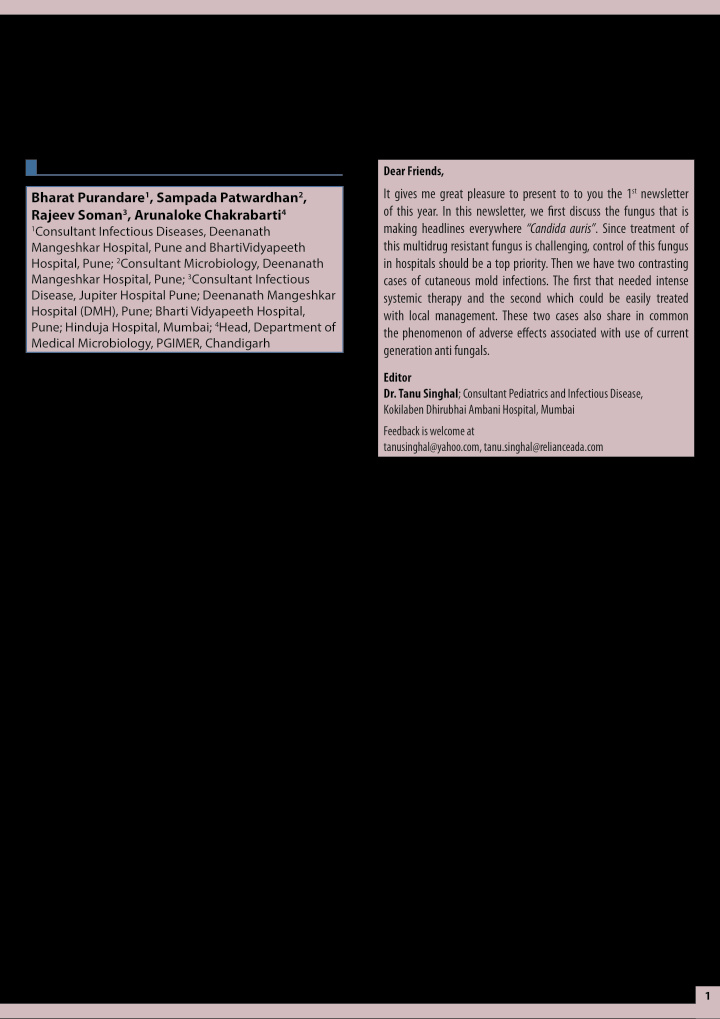



Fungal Infections Study Forum www.fjsftrust.org Volume 3, Issue 1 Candida auris is here Dear Friends, It gives me great pleasure to present to to you the 1 st newsletter Bharat Purandare 1 , Sampada Patwardhan 2 , of this year. In this newsletter, we first discuss the fungus that is Rajeev Soman 3 , Arunaloke Chakrabarti 4 making headlines everywhere “Candida auris” . Since treatment of 1 Consultant Infectious Diseases, Deenanath this multidrug resistant fungus is challenging, control of this fungus Mangeshkar Hospital, Pune and BhartiVidyapeeth in hospitals should be a top priority. Then we have two contrasting Hospital, Pune; 2 Consultant Microbiology, Deenanath Mangeshkar Hospital, Pune; 3 Consultant Infectious cases of cutaneous mold infections. The first that needed intense Disease, Jupiter Hospital Pune; Deenanath Mangeshkar systemic therapy and the second which could be easily treated Hospital (DMH), Pune; Bharti Vidyapeeth Hospital, with local management. These two cases also share in common Pune; Hinduja Hospital, Mumbai; 4 Head, Department of the phenomenon of adverse effects associated with use of current Medical Microbiology, PGIMER, Chandigarh generation anti fungals. PO 40 M was admitted at DMH with non H1N1 bilateral pneumonia Editor requiring intubation, mechanical ventilation, various recruitment Dr. Tanu Singhal ; Consultant Pediatrics and Infectious Disease, techniques for persistent hypoxia & finally ECMO. He developed acute Kokilaben Dhirubhai Ambani Hospital, Mumbai kidney injury requiring hemodialysis, critical illness myoneuropathy, Feedback is welcome at bilateral vocal cord palsy and a left shoulder dislocation. While gradually tanusinghal@yahoo.com, tanu.singhal@relianceada.com recovering from all these complications, he developed hemophagocytic issued advisories, which is the first for any fungal disease. lymphohistioctytosis (HLH). He was initially treated with steroids followed by etoposide. He gradually improved and was discharged after The reasons for such alarm are: a) the fungus cannot be easily identified a prolonged ICU stay. The patient was later readmitted with headache. especially by conventional technique, b) the organism is easily Lumbar puncture and CSF analysis was diagnostic of cyptococcal transmitted by colonization and contamination of hospital environment, meningitis by both cryptococcal antigen test and later culture. A central c) difficult to treat as the organism is multi-drug resistant, d) it causes line was inserted and treatment with amphotericin B deoxycholate severe infection. A multi-centre Indian ICU study involving 27 ICU’s & fluconazole was initiated. During treatment, he developed fever & during 2011-2012 reported 5.3% of candidemia cases as due to C. auris paired blood culture revealed growth of yeast. Automated identification in 18 ICUs across the country 1 . Longer ICU stay, multiple interventions system identified the organism as Crytpococcus laurentii . However, and prior fluconazole exposure were risk factors for infection 2 . The source the colonies tested negative by the cryptococcal antigen detection of the agent is possibly in the hospital environment, as the agent has test. Hence, the isolate was sent to PGIMER Chandigarh, where it never been isolated from the community. Whole genome sequencing of was identified as Candida auris by DNA sequencing. The isolate was 47 isolates identified four clades (South Asia, South Africa, East Asia and susceptible to 5 fluorocytosine, caspofungin, micafungin, anidulafungin South America) for this agent with little variation among the strains in and voriconazole, but resistant to fluconazole and amphotericin B. The each clade 3 . patient was treated with caspofungin, voriconazole & 5fluorocytosine. Despite this treatment, changing lines, & ruling out endocarditis with The agent is not easily identified by conventional techniques as in our transesophageal echocardiography (TEE), candidemia could not be case. Our agent was identified as Cryptococcus laurentii by conventional cleared. The patient had multiple relapses of HLH and could not be taken technique. By API-20C, Vitek 2, BD Phoenix, Microscan, the agent is off immunosuppressive treatment. The patient’s family decided to limit often misidentified as Candida haemulonii, C. famata, C. lusitaniae, treatment and the patient finally succumbed to his illness. C. parapsilosis, C. sake, Cryptococcus laurentii, Rhodotorulaglutinis, Saccharomycescerevisiae etc 4 . Only the improved database of MALDI-TOF This case highlights that despite all our efforts, the patient succumbed to and DNA sequencing can accurately identify the agent. These techniques Candida auris, a multi-drug resistant fungal pathogen which is emerging are not available in most of the laboratories in India. Hence, laboratory as a major threat. The story of C. auris is unique as it has unfolded within personnel should suspect the agent when any Candida species is multi- a relatively short period from 2009 through 2017 involving patients of multiple countries in five continents, which is unlike the behavior of any drug resistant, grows at higher temperature (42 o C), fails to grow in the fungal disease. CDC (Centers for Disease Control & Prevention) of USA, presence of cycloheximide, and utilizes dextrose, dulcitol and mannitol 2 . Public Health of England, ECDC (European Centre for Disease Prevention The isolate can be confirmed at Reference laboratory at PGIMER, and Control) of Europe and Indian Council of Medical Research have Chandigarh (ICMR advisory). 1
Recommend
More recommend